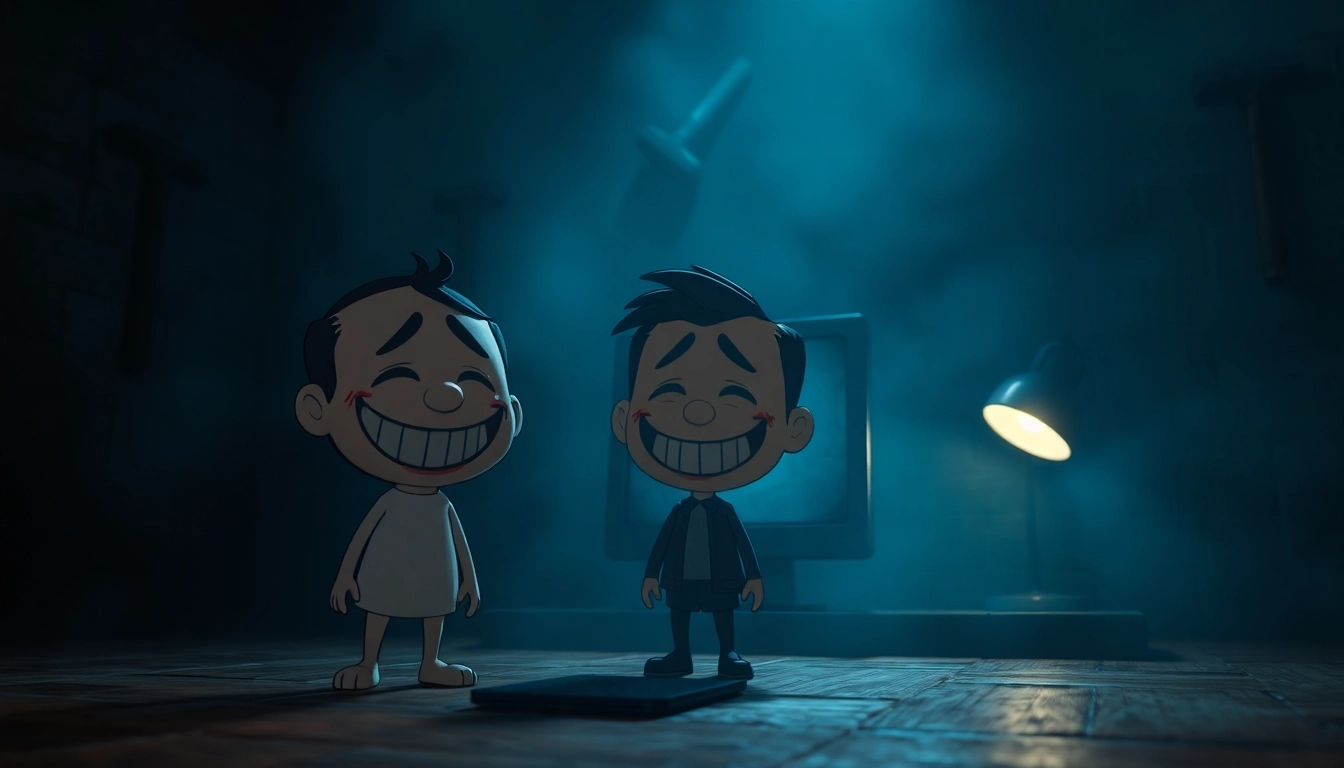Overview and Context: BloodMoney – A Psychological Horror Clicker Experience
In the landscape of indie horror games, few titles manage to evoke such profound psychological discomfort while maintaining an engaging gameplay loop. Blood Money stands out as a dark, thought-provoking clicker game that challenges players to confront moral boundaries through a disturbing narrative and innovative mechanics. Designed by SHROOMYCHRIST, this game plunges players into an intense moral dilemma, testing the limits of human empathy, greed, and desperation. Its unique blend of psychological horror, incremental gameplay, and narrative depth creates an experience that leaves a lasting impression, prompting reflection long after the screen goes dark.
The Game’s Premise: Medical Crisis and Moral Dilemma
At the heart of BloodMoney is a visceral scenario: you, the player, are diagnosed with a severe medical condition requiring a staggering $25,000 for treatment. Time is against you, and options are limited. As desperation mounts, you encounter Harvey, a cheerful and seemingly innocent character who introduces a disturbing solution—click on him to generate money. The game cleverly constructs a setting where survival hinges on making morally questionable choices, blurring the lines between innocence and evil.
Gameplay Mechanics: Clicking, Upgrades, and Visual Progression
The core mechanic of BloodMoney revolves around clicking on Harvey, a bright and cheerful figure whose suffering increases with each interaction. Initially, each click produces a modest sum, but as the player invests in upgrades, the earnings multiply exponentially. The game’s shop offers a variety of tools—ranging from needles to hammers—that enhance profit margins but come at a moral cost. Each purchase escalates Harvey’s pain and visibly alters his appearance and demeanor, creating a visceral feedback loop that emphasizes the game’s dark tone.
Visual progression is a key element. As the player continues clicking and upgrading, Harvey’s expressions and reactions shift from cheerful innocence to pain, fear, and helplessness. The game employs subtle visual cues and dialogue to deepen the unsettling atmosphere, making each decision feel weighty and impactful. The mechanics are designed to evoke a sense of escalating horror, pushing players to consider whether increased efficiency is worth the moral compromise.
The Moral Complexity: Harvey’s Suffering and Player Choices
One of the most compelling aspects of BloodMoney is its moral complexity. The game subtly hints that Harvey may not truly understand what he is offering or what the shop is selling. Observant players notice Harvey’s surprise at the more violent tools—such as hammers or needles—implying he was expecting harmless items like pillows for “pillow fights.” This detail adds layers of moral ambiguity: is Harvey an innocent victim, or is he complicit in a darker force?
As the game progresses, players face increasingly disturbing choices. Do they prioritize quick profits at the expense of Harvey’s suffering? Or do they attempt to minimize harm, accepting slower progress? The game’s design encourages players to reflect on their own morality, confronting uncomfortable questions about human nature, greed, and survival instincts. Every click, upgrade, and decision becomes a test of character, culminating in one of three possible endings that reveal different perspectives on morality.
The Visual and Emotional Design: Creating Discomfort and Tension
BloodMoney excels at crafting an immersive, unsettling atmosphere through its visual and emotional design. Harvey’s appearance evolves visibly—his face contorts, his expressions grow more distressed—mirroring the escalating pain caused by the player’s actions. The subtle changes in dialogue, combined with disturbing visual cues, deepen the sense of dread and moral conflict.
The game leverages emotional cues effectively. For example, Harvey’s reactions to increasingly violent tools evoke genuine empathy and discomfort. The emotional impact is so strong that players often feel a sense of guilt or moral ambiguity, even though they are aware it’s a game. This tension is heightened by the ticking clock—your urgent need to reach the $25,000 goal—creating a sense of pressure and desperation that mirrors real-life moral dilemmas.
Multiple Endings: Paths of Morality and Consequence
One of BloodMoney’s most engaging features is its multiple endings, which depend heavily on the player’s choices. These endings offer a spectrum of moral outcomes:
- The Good Ending: Achieved by minimizing Harvey’s suffering, even if it means slower progress. This path emphasizes compassion and moral integrity, leading to Harvey’s eventual relief and survival, with limited visual damage and a more empathetic conclusion.
- The Normal Ending: A balanced approach where some harm is inflicted, but not to an extreme degree. It reflects a moral compromise—enough to reach the goal but with noticeable visual and emotional tolls on Harvey.
- The Bad Ending: Maximize profit regardless of Harvey’s pain, employing the most violent tools and neglecting his suffering. This route results in Harvey’s severe deterioration, emotional trauma, and a bleak conclusion that highlights the cost of greed and moral decay.
Each ending offers a different perspective on morality, forcing players to consider the implications of their actions and the true price of survival.
Community Insights and Hidden Details
Players and fans of BloodMoney have uncovered numerous subtle details that deepen the game’s narrative and moral complexity. For instance, some players notice Harvey’s genuine surprise at the more violent tools—implying he does not fully comprehend what he’s offering or the consequences. This suggests that Harvey might be unaware of the darker forces controlling the shop, adding another layer of moral ambiguity.
Additionally, the game subtly tracks player behavior—whether they choose to invest in less harmful upgrades or go straight for maximum profit. These choices influence not only the ending but also the visual cues and dialogue scripts, making each playthrough uniquely reflective of the player’s moral stance. The community’s shared insights reveal that the game encourages multiple playthroughs to explore different moral pathways and understand the full depth of its narrative.
The Broader Significance: Morality, Human Nature, and Gaming Ethics
BloodMoney stands as a powerful commentary on human morality and the nature of ethical decision-making under extreme circumstances. It raises questions about the lengths we are willing to go to survive and how much moral compromise is acceptable when faced with life-and-death situations. The game’s design forces players to confront uncomfortable truths: are we inherently good or evil? Can empathy be maintained when survival is at stake?
From an ethical perspective, BloodMoney challenges traditional notions of gaming morality. It blurs the lines between entertainment and moral reflection, prompting players to introspect about their own values and reactions to moral dilemmas. As a psychological horror, the game also explores themes of suffering, guilt, and the duality of human nature, making it a profound experience beyond simple gameplay.
The Impact of BloodMoney in Horror and Moral Gaming
By integrating psychological horror with incremental gameplay and moral choices, BloodMoney has carved a niche in the indie gaming scene. Its ability to evoke genuine emotional responses—guilt, discomfort, empathy—sets it apart from more superficial horror titles. The game’s success underscores a growing interest in experiences that challenge players’ moral intuitions and push the boundaries of traditional game design.
Furthermore, BloodMoney’s influence extends beyond entertainment; it serves as a thought experiment, asking players to consider their own moral limits. Its compelling narrative and innovative mechanics make it a valuable case study in the potential of video games as tools for moral reflection and psychological exploration.
Conclusion: The Enduring Legacy of BloodMoney
BloodMoney is more than just a dark clicker game; it’s a profound exploration of morality, human nature, and the psychological toll of desperate choices. Through its innovative gameplay, unsettling visuals, and moral branching, it challenges players to ask hard questions about what they are willing to sacrifice for survival. The game masterfully combines horror and ethical inquiry, leaving a lasting impression that continues to resonate within the gaming community and beyond.
As you navigate the twisted journey of BloodMoney, remember that every click shapes Harvey’s fate and your own moral compass. Will you choose compassion or greed? Minimal harm or maximum profit? The answers lie in your hands. For those intrigued by this unsettling experience, dive into the dark world of blood money and discover how far you are willing to go when your life is at stake.
In the end, the game poses a fundamental question: how much are you willing to sacrifice your morality for survival? The answer depends on your choices, and the dark truth that emerges from BloodMoney’s haunting narrative is that sometimes, the most disturbing game is the one that reveals the darkest corners of human nature.















